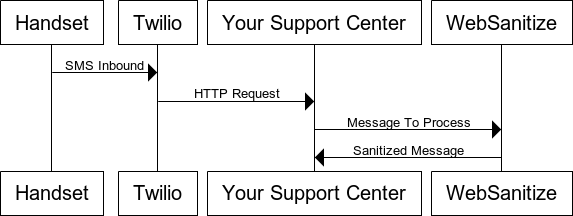An ever increasing problem in the digital age is the continual use and unwanted exposure of rude words and profanity. Thinking about this from a business perspective its never great when your customer service agents are exposed to an angry customer who does nothing but swear in a real time live chat.
Lets take for example a (Twilio) SMS powered customer support channel.
The standard work flow would be

Raw Inbound Request
Here the message comes into your support application, the raw content is added to a ticket or messaging system and is presented to your customer agent.
If this inbound contains profanity or other rude words your agents are immediately exposed to this.
Fortunately I’ve found a service that scans text bodies for rude words and replaces them – WebSanitize.
Using WebSanitize you can implement a profanity filter at the server or application layer.
This lets you build a workflow into your inbound messages process.

In layman’s terms we can add a method to scan inbound messages for profanity and replace the words.
This gives you the option of adding a layer between the rude inbound messages and our / your customer service agents.
Getting started with WebSanitize
The core of WebSanitize is fast API, to get started you need to sign up for an account with them. Once you have an API Key the request is fairly straight forward:
To make a request you need to pass the following details:
| URL | https://api.websanitize.com/message |
| API Key | Your API Key |
| Content-type | application/json |
| filter | ‘word’ or ‘character’ |
| message | The message you want inspected |
An example API request would be:
curl -XPOST -H ‘x-api-key: This1sN0tS3cure’ \
-H “Content-type: application/json” \
-d ‘{“filter”:”word”, “message”:”What the fuck man!”}’ \
‘https://api.websanitize.com/message’
Here the message that needs to be inspected is: “What the fuck man!” and the API is going to perform a word swap if it finds any profanity.
The response to the above request is:
{
“JobID”:”u4C9JTNPB3a8ykplhAi8YJyzXodGoF”,
“MessageAlert”:true,
“OriginalMessage”:”What the fuck man!”,
“CleanerMessage”:”what the duck man!”
}
The return response contains
| JobID | A unique ID for this request |
| MessageAlert | true/false if a banned word was found |
| OriginalMessage | The original unfiltered message |
| CleanerMessage | The cleaned message |
The first thing to notice is that ‘MessageAlert‘ flag has been set to true. You can use this as a first step to see if you need to replace the original text is to check this status. e.g.:
if(MessageAlert == true){
// Replace the original text using the returned variable CleanerMessage
} else {
// The original message did not contain any profanity
}
With this ‘Sanitized’ message replacing the original one we can present this to our customer support agent.
Why use WebSanitize or any kind of screening service?
It’s often said that a companies best asset is the people.
If you think about the abuse and language thats occasionally used by irate people when they speak to customer service agents, any barrier or in this case a ‘Sanitizer’ that can shield an employee from those harsh words is always a good thing.
Using a service like WebSanitize gives your customer service agents confidence that you or your organisation are proactively taking steps to keep them safe and shielded from those undesirable words.